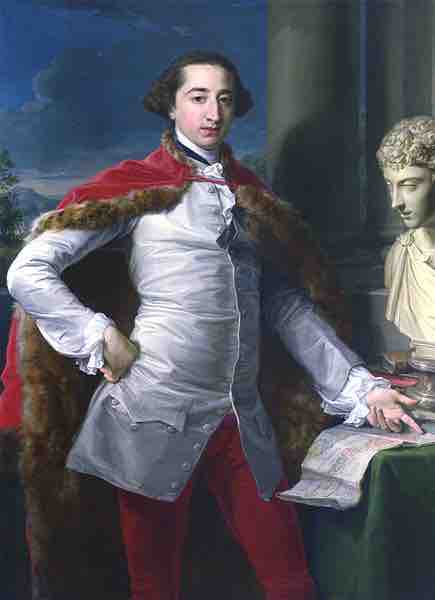The Grand Tour was a customary trip to Europe undertaken by wealthy Europeans and some Americans that flourished as a tradition from about 1660 to 1840. The trip was viewed as an educational rite of passage typically for young men, but sometimes women as well. It was intended as a means of cultural broadening and associated with a fairly standard itinerary. The Grand Tour tradition was extended to include the middle class when railroad and ship travel became more widespread in the second half of the 18th century.
The travel itinerary typically began in Dover, England and crossed the English Channel to Ostend or to Calais in France. From here the tourist and "bear-leader," or tutor, and possibly a troupe of servants, could rent a coach and travel to Paris. From Paris they would travel to Switzerland, then Spain, and Northern Italy. Once in Italy, the tourist would visit Turin, and might spend a few months in Florence and Venice, which was the epitome of the Grand Tour for most British tourists. From Venice they would go to Rome to study the ruins and masterpieces and possibly to the archaeological sites at Pompeii. Next was the German section of Europe, such as Vienna, Dresden, Berlin, and Potsdam, and finally to Holland and Flanders before making the trip home. The journey generally involved the study of art at museums and universities, private collections, and notable architectural sites.
The pilgrimage was popularized further by the advent of tour guides, such as Thomas Cook, which became synonymous with the Grand Tour. Grand Tourists were known to travel with an entourage that included valets, coachmen, scholarly guide and possibly a cook. Souvenirs and mementos became an important element as they could demonstrate the specifics of which location was visited and what was seen or acquired. Their popularity created an industry of sorts, and prices rose with the growth of the trend. Some Grand Tourists invited artists from home to accompany them throughout their travels, painting views specific to their personal itineraries.
Despite the political upheaval, 18th-century Rome remained a desirable destination. It became an absolute necessity for people of means to spend time in Rome as part of their "Grand Tour," or educational pilgrimage. The city became a nexus for these tourists as well as the merchants and industries that resulted from their patronage. The increasing popularity of the Grand Tour, and the related desire for visitors to collect "classical" souvenirs, quickly spread the Neoclassical style throughout Europe. It became a symbol of wealth and freedom to go on the Grand Tour and to have something to show for it displayed in your home.A popular souvenir of the Grand Tour was a portrait of the tourist themselves, often painted amidst the architecture, or famous art works of a particular European location. The artist Pompeo Batoni, made a career of painting portraits of English tourists posed among Roman antiquities. He became very popular in Rome and his portraits of the British traveling through the city were in very high demand. There are records of over 200 portraits of visiting British patrons standing amidst ruins and great works of art by Batoni. These paintings made it into numerous private collections in Britain, thus ensuring the genre's popularity in the United Kingdom.

A portrait by Pompeo Batoni
A popular souvenir of the Grand Tour was a portrait of the tourist themselves, often painted amidst the architecture, or famous art works of a particular European location.